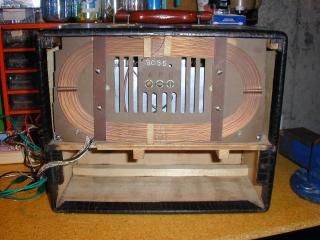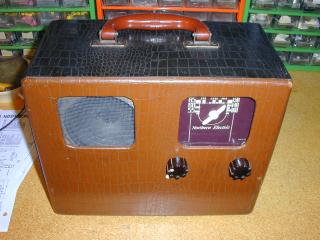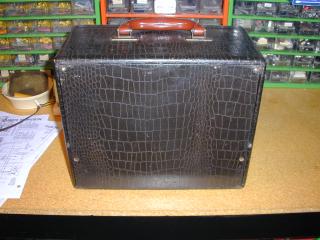
Manufacturer: Northern Electric, Toronto, Canada
Model: B4100
Approximate Date Of Manufacture: 1946-47
Type: 4-tube Superheterodyne AM BC band radio
Tube lineup: 1A7GT, 1N5GT, 1H5GT, 3Q5GT
Status: unknown, not restored
Where purchased: eBay, September 2005
It is intended to operate on a 1.5 or 2.0 volt 'A' battery and 2 45 volt 'B' batteries.
The seller on ebay did not state the model. It was marked inside and the schematic was located in the RCC manuals.
It has an internal loop antenna and external antenna and ground connections. There is room in the bottom of the case for the batteries. These are not generally available anymore and I intend to power it using a power supply.
The case is a little dirty but should clean up to look quite good. The inside is quite clean although the chassis and metal parts are covered in a layer of yellow powder -- possibly just corrosion or mould or it could be cadmium plating. Since cadmium is toxic I will take care when cleaning it.
The buyer said he could not test the radio but that the tubes tested good -- I find that hard to believe as the tubes are covered in a thin layer of dust with no evidence of anyone having touched them for years. They are also very tight in the sockets as if they have not been removed for along time.
The circuit is pretty standard. There is a terminal screw marked 'P' which appears to be for a phono input. Since it is a battery set, no rectifier is required, reducing the tube count by one. There is also no need for power supply filtering so there is only one electrolytic cap, used in the output amp. This is the only radio I own that uses 1 and 3 volt octal base tubes. The same chassis was using in models B4100 through B4104.
Restoration is underway and will be documented here as it proceeds.
I did some cleaning of the case with Murphy's Oil Soap.
Bad news! I tested the tubes and every one has an open filament. Some genius must have connected the wrong voltage to the 'A' supply for the filaments and blew every tube. These 1 and 3 volt tubes are delicate and will be destroyed almost instantly if a higher voltage is applied. Looks like this radio is going to be more expensive to restore than I thought (fortunately the radio cost me less that $20). At least these tubes are all under $5.00 each even when purchased from on-line stores.
Replaced the old dial cover with a piece of plastic cut from some packaging. It only requires flat plastic and this seemed to be an exact match for the right thickness. The old one was yellow, scratched, and warped.
Did more cleaning of the cabinet including applying of some shoe polish.
All resistors measured within spec and oscillator coil and IF transformers had correct resistances. The audio output transformer has an intermittent connection in the primary - it may need to be glued or soldered in place. I set aside replacement paper and electrolytic caps, but did not install them yet as I prefer to test the radio first and replace them one at a time.
I replaced the electrolytic and paper caps and took some pictures.
I reassembled the chassis in the case and took a few final pictures.















